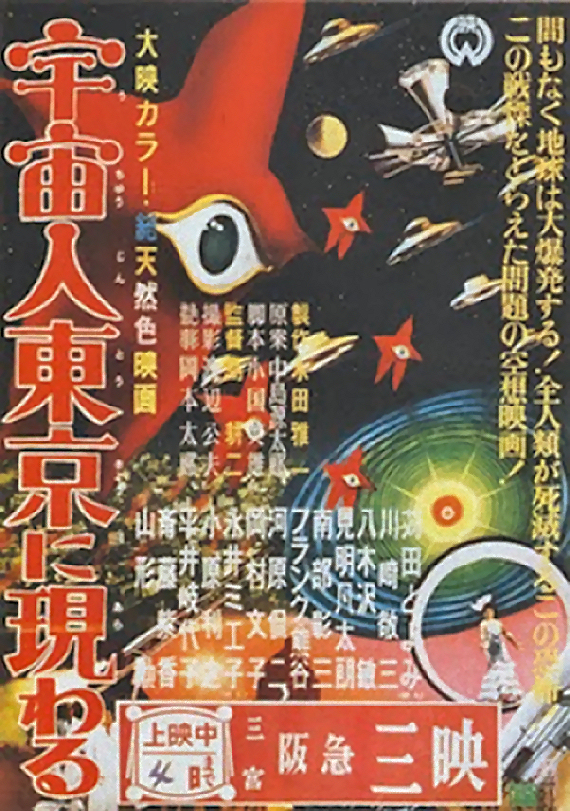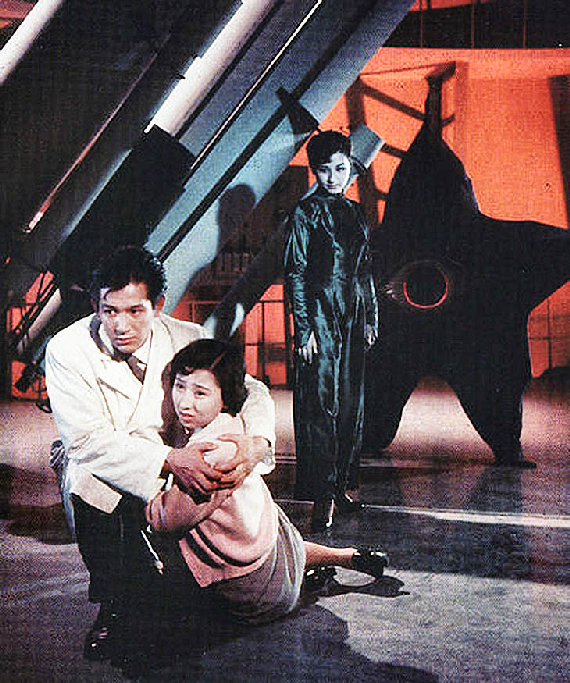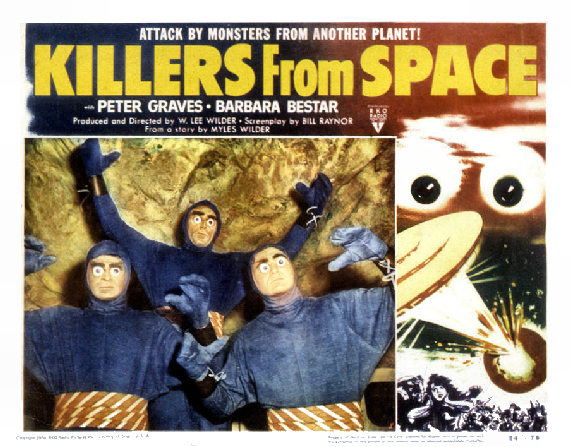ONE EYE GOOD—TWO EYE BAD! Two Retro Movie Reviews
 Happy Canada Day (July 1)! This column marks my 150th consecutive (more or less) column for Amazing Stories Online. So that’s about three years’ worth—somewhere around 300,000 words, believe it or not! I’m rather proud of that accomplishment; last time I wrote for Amazing (print issues, back in the ‘80s) I was nowhere near as consistent nor as prolific (to be fair, I think it was bimonthly back then—I’d have to check; I was doing the fan/fanzine/conventions column (now known again as The Clubhouse, under the aegis of my friend and yours, R. Graeme Cameron, or The Graeme, as we call him). Anyway, this column may be shorter than usual, as we’re all a bit scattered here at home and may have to go suddenly to the Midwest because of illness in the family… and if I miss next week or the week after, you’ll know why. So, on to the next round (as Monty Python says)! The following two reviews are of fifty- or sixty-year-old movies, and so will contain spoilers!
Happy Canada Day (July 1)! This column marks my 150th consecutive (more or less) column for Amazing Stories Online. So that’s about three years’ worth—somewhere around 300,000 words, believe it or not! I’m rather proud of that accomplishment; last time I wrote for Amazing (print issues, back in the ‘80s) I was nowhere near as consistent nor as prolific (to be fair, I think it was bimonthly back then—I’d have to check; I was doing the fan/fanzine/conventions column (now known again as The Clubhouse, under the aegis of my friend and yours, R. Graeme Cameron, or The Graeme, as we call him). Anyway, this column may be shorter than usual, as we’re all a bit scattered here at home and may have to go suddenly to the Midwest because of illness in the family… and if I miss next week or the week after, you’ll know why. So, on to the next round (as Monty Python says)! The following two reviews are of fifty- or sixty-year-old movies, and so will contain spoilers! Okay, we know that Japanese culture is—if you’re from North America—often as weird as if it came from another planet (don’t get me wrong; I’ve long been an admirer of Japanese culture, and I used to speak fairly fluent Japanese. But I’ve not used it in many years and can no longer read, write or speak Japanese); and Japanese SF movies have brought some wonderful weirdness into SF culture over the last umpty-ump years. I mean, look at Godzilla, Mothra, Rodan et al., plus the numerous ‘fifties and ‘sixties Japanese SF movies involving space. Well, I have an entry into the “weird Japanese SF movie” Hall of Fame and, surprisingly (to me, at least), quite a few people are already familiar with it. Warning From Space was made in 1956 (which, if you’re keeping track, is 60 years ago!) and was the very first colour Japanese SF movie. Yes, before this movie was Gojira (1954), but that was in glorious black and white! And this one doesn’t have any Canadian-American stars (like Raymond Burr, in the 1956 re-release of Godzilla) pasted in to capture the overseas market. There are several reasons why this movie is worth watching. If you’re looking for a modern movie full of exploding bullets (or explosions in general), car chases or fist fights, this isn’t the droid you’re looking for. If you’re looking for a fairly thoughtful (and subtle, in places) exploration of “first contact” combined with “worlds in collision” themes, this just might be it. Let’s take a quick look at the plot.
Okay, we know that Japanese culture is—if you’re from North America—often as weird as if it came from another planet (don’t get me wrong; I’ve long been an admirer of Japanese culture, and I used to speak fairly fluent Japanese. But I’ve not used it in many years and can no longer read, write or speak Japanese); and Japanese SF movies have brought some wonderful weirdness into SF culture over the last umpty-ump years. I mean, look at Godzilla, Mothra, Rodan et al., plus the numerous ‘fifties and ‘sixties Japanese SF movies involving space. Well, I have an entry into the “weird Japanese SF movie” Hall of Fame and, surprisingly (to me, at least), quite a few people are already familiar with it. Warning From Space was made in 1956 (which, if you’re keeping track, is 60 years ago!) and was the very first colour Japanese SF movie. Yes, before this movie was Gojira (1954), but that was in glorious black and white! And this one doesn’t have any Canadian-American stars (like Raymond Burr, in the 1956 re-release of Godzilla) pasted in to capture the overseas market. There are several reasons why this movie is worth watching. If you’re looking for a modern movie full of exploding bullets (or explosions in general), car chases or fist fights, this isn’t the droid you’re looking for. If you’re looking for a fairly thoughtful (and subtle, in places) exploration of “first contact” combined with “worlds in collision” themes, this just might be it. Let’s take a quick look at the plot.
Doctor Matsuda (Isao Yamagata) has just invented a new type of explosive, one that’s a hundred times more powerful than even the atomic bomb. So far, it’s just a formula, but if it can be manufactured, it might be the answer to Earth’s energy needs. Not very coincidentally, we find out that Earth has been observed for a very long time (thousands of years) by aliens from the planet Piera, which is opposite Earth (from the Sun) in the exact same orbit as Earth, which is why it’s never been discovered. The Pierans are way ahead of Earth’s people scientifically, and have maintained a space station in orbit around Earth for years so they can observe us. They have also observed a strange wandering planet (“Planet R”), which is rushing towards Earth at a high rate of speed, and we Earthians (or Earthlings or denizens of planet Earth, whatever we are) haven’t even seen it yet. If it hits the Earth—which it appears bound to do so, the effect will be to destroy Earth and Peira as well. They decide they need to contact Earth for two reasons: first, to destroy Dr. Matsuda’s formula, which is a danger to the entire universe; and secondly, to warn us about Planet R. For those reasons, they decide to contact the scientists of Japan, who are more advanced than other Earth scientists. First, they try appearing in various places in Japan, but that doesn’t work so well… y’see, they’re kinda odd-looking. They look like human-sized starfish with an eyeball in the middle! (See Figure 2, upper-left-hand corner. And every time a Japanese person sees one, he or she hollers “Monster!” and runs away. Hmm. This just isn’t working! So one of them, Ginko (Toyomi Karita) sees a poster for a popular singer/dancer (though, trust me, she’s a lousy dancer) named Hikari Aozara, and changes into a virtual duplicate of her! Clever starfish! Except for the way she can walk through walls, jump fifteen feet in the air and disappear/reappear at will, she’ll definitely pass for human! Anyway, she goes to find Dr. Matsuda, sees his formula and rips it up! She tells him it’s too dangerous for mankind, because even a tiny bit of it could destroy everything. Anyway, time passes, and the Pierans make themselves known to humankind and warn them about Planet R. The Japanese scientists have a plan to save the Earth from Planet R, however: if all the members of Earth’s Atomic Club put all their atomic bombs and H-bombs together, they could possibly either blow up Planet R or make it change course and miss the Earth. So they put this plan to the World Council, which brushes them off, ‘cause frankly, nobody believes in Planet R or aliens (especially giant starfish aliens) from space! Anyway, as Planet R gets closer and closer, Earth begins to heat up, and there are cyclones, and earthquakes, and other terrific Japanese models… I mean, things happening, and finally, the World Council agrees. All the atomic-enabled countries put all their A- and H-bombs together and shoot them at Planet R, which by now you can practically see with the naked eye. Planet R shrugs them off, and there are only something like 20 days left before a) Earth boils off, because Planet R is really, really hot; and b) Planet R and Earth do the hootchie-kootchie and both of them go kaboom!
First, they try appearing in various places in Japan, but that doesn’t work so well… y’see, they’re kinda odd-looking. They look like human-sized starfish with an eyeball in the middle! (See Figure 2, upper-left-hand corner. And every time a Japanese person sees one, he or she hollers “Monster!” and runs away. Hmm. This just isn’t working! So one of them, Ginko (Toyomi Karita) sees a poster for a popular singer/dancer (though, trust me, she’s a lousy dancer) named Hikari Aozara, and changes into a virtual duplicate of her! Clever starfish! Except for the way she can walk through walls, jump fifteen feet in the air and disappear/reappear at will, she’ll definitely pass for human! Anyway, she goes to find Dr. Matsuda, sees his formula and rips it up! She tells him it’s too dangerous for mankind, because even a tiny bit of it could destroy everything. Anyway, time passes, and the Pierans make themselves known to humankind and warn them about Planet R. The Japanese scientists have a plan to save the Earth from Planet R, however: if all the members of Earth’s Atomic Club put all their atomic bombs and H-bombs together, they could possibly either blow up Planet R or make it change course and miss the Earth. So they put this plan to the World Council, which brushes them off, ‘cause frankly, nobody believes in Planet R or aliens (especially giant starfish aliens) from space! Anyway, as Planet R gets closer and closer, Earth begins to heat up, and there are cyclones, and earthquakes, and other terrific Japanese models… I mean, things happening, and finally, the World Council agrees. All the atomic-enabled countries put all their A- and H-bombs together and shoot them at Planet R, which by now you can practically see with the naked eye. Planet R shrugs them off, and there are only something like 20 days left before a) Earth boils off, because Planet R is really, really hot; and b) Planet R and Earth do the hootchie-kootchie and both of them go kaboom! So they need Dr. Matsuda’s formula… but there’s a problem! Dr. Matsuda has been abducted by a criminal who wants the formula for himself! Fortunately, even though he’s been tied to a chair and gagged for a month (according to what they said in the movie) he’s suffered no ill effects and the Peirans track him down using his special two-way-radio ring, which they gave him, and which shows up really well on radar! Matsuda is saved, the Peirans make his formula and Planet R blows up and everyone is happy! Do you remember how at the end of Mars Attacks there are all kinds of animals to show that everything’s okay? And at the end of Crack in the Earth (I told you about this last week) there were chipmunks to show you that all was well? Well, at the end of this one, they have a rat, a raccoon, some crabs and some turtles to show you that the world will continue as usual! (How Japanese! How… weird!) Anyway, all’s well that ends well.
So they need Dr. Matsuda’s formula… but there’s a problem! Dr. Matsuda has been abducted by a criminal who wants the formula for himself! Fortunately, even though he’s been tied to a chair and gagged for a month (according to what they said in the movie) he’s suffered no ill effects and the Peirans track him down using his special two-way-radio ring, which they gave him, and which shows up really well on radar! Matsuda is saved, the Peirans make his formula and Planet R blows up and everyone is happy! Do you remember how at the end of Mars Attacks there are all kinds of animals to show that everything’s okay? And at the end of Crack in the Earth (I told you about this last week) there were chipmunks to show you that all was well? Well, at the end of this one, they have a rat, a raccoon, some crabs and some turtles to show you that the world will continue as usual! (How Japanese! How… weird!) Anyway, all’s well that ends well.
One of the things I really liked about this movie (besides the usual fabulous Japanese SF movie model work—they really were masters at this sort of stuff), and I wish our copy had been a lot better—we ended up watching what looked like a second- or third-generation VHS copy—was that this movie took place only ten years after the end of the Second World War, and all of Japanese society had not yet been Westernized. So you caught little glimpses of pre-war Japan here and there. Anyway, I liked this: the aliens were totally different from any Western alien, and the effects were, for 1956, pretty darned good, even if the pace was a bit slow from time to time. And the aliens (the Pierans) were here to help, not to conquer. The other thing is that here it is only ten years or so after a couple of Japanese cities were blasted with real atomic fire, and Japanese movie makers were figuratively beating the atomic swords into atomic plowshares! Pretty advanced, eh?  Our next project is a bit of a change: first, it’s not in colour. Yes, it’s in glorious black and white! Secondly, it’s not a very good movie, even if it has that star of stage, screen and Mission Impossible, Peter Graves! (A very young Peter Graves, at that! Why, his hair is blond, not grey or white!) Here’s the plot, what there is of it. The U.S. is doing atomic testing in the Southwest (I guess I’ve blanked on the actual state), and Dr. Douglas Martin (Peter Graves) is in a jet fighter (“Tar Baby 2”), taking some kind of aerial measurements in the blast cloud (!?) He spots some kind of blinking light on the ground near the blast centre, and instructs his pilot to get closer, but as the pilot does, the controls cease to respond, and the plane crashes. Dr. Martin and the pilot are presumed dead, as only the pilot’s body is found in the wreckage—Martin is presumed to have been scattered in a zillion pieces—and his wife Ellen (Barbara Bestar) is notified by his working partner, Dr. Curt Kruger (Frank Gerstel). Days later, his clothing in shreds and tatters, Dr. Martin staggers in from the desert looking pretty alive. He’s taken to a hospital, where doctors pronounce him more or less healthy, except for an odd “L”-shaped scar on his chest that apparently wasn’t there before the plane crash. The Air Base personnel, led by Col. Banks (James Seay) and medic Dr./Major Clift (Shep Menken) try to get information from him as to what happened and where he’s been, but Martin is blank; can’t remember anything.
Our next project is a bit of a change: first, it’s not in colour. Yes, it’s in glorious black and white! Secondly, it’s not a very good movie, even if it has that star of stage, screen and Mission Impossible, Peter Graves! (A very young Peter Graves, at that! Why, his hair is blond, not grey or white!) Here’s the plot, what there is of it. The U.S. is doing atomic testing in the Southwest (I guess I’ve blanked on the actual state), and Dr. Douglas Martin (Peter Graves) is in a jet fighter (“Tar Baby 2”), taking some kind of aerial measurements in the blast cloud (!?) He spots some kind of blinking light on the ground near the blast centre, and instructs his pilot to get closer, but as the pilot does, the controls cease to respond, and the plane crashes. Dr. Martin and the pilot are presumed dead, as only the pilot’s body is found in the wreckage—Martin is presumed to have been scattered in a zillion pieces—and his wife Ellen (Barbara Bestar) is notified by his working partner, Dr. Curt Kruger (Frank Gerstel). Days later, his clothing in shreds and tatters, Dr. Martin staggers in from the desert looking pretty alive. He’s taken to a hospital, where doctors pronounce him more or less healthy, except for an odd “L”-shaped scar on his chest that apparently wasn’t there before the plane crash. The Air Base personnel, led by Col. Banks (James Seay) and medic Dr./Major Clift (Shep Menken) try to get information from him as to what happened and where he’s been, but Martin is blank; can’t remember anything. Dr. Clift says he’s probably blocking due to a great mental stress, and agrees to give him sodium amethol (not quite sure what that is), so that he will be unable to block his memories or even invent something that didn’t happen. He is given the amethol and his memory begins to return; he remembers that the plane crashed, and he woke up on some kind of a table with a weird mechanical arm doing something to his chest, and a bunch of bug-eyed aliens crowding around (Figure 6). Turns out he was dead, and the mechanical thingy was replacing his heart after it was repaired. The bug-eyed aliens, led by someone called Deneb (or The Tala) (John Frederick), need him, Martin, as a scientist, to get the information on the upcoming A-bomb tests. These aliens (sorry, I’ve got a mental block now and can’t remember if they said their collective name) have lived in caves on their home planet (hence the bug eyes), which actually isn’t their home planet at all… what they do is move from planet to planet, stealing that planet’s energy and using it to live on; then when that planet is used up, they move to another one. The Earth is next; they’ve already begun stealing the energy from atomic testing, and need to know when the next one is due so they can complete their plans—which include loosing zillions of giant bugs, spiders, snakes, etc., to wipe all life off the face of the planet—so when the planet is empty of life, the Bug-Eyes will move in in their billions and live off this planet till it’s time to do it again. Dr. Martin (or maybe his colleague Dr. Kruger—mental block, remember?) figures out that if the aliens are powered by our atomic power—in fact, are stealing our power from the power station—then we can destroy them by turning off the power, which will reverse something or other and make them blow up. So Martin does—everyone and his uncle are trying to prevent him from doing so, for reasons that escape me—and the aliens go boom!
Dr. Clift says he’s probably blocking due to a great mental stress, and agrees to give him sodium amethol (not quite sure what that is), so that he will be unable to block his memories or even invent something that didn’t happen. He is given the amethol and his memory begins to return; he remembers that the plane crashed, and he woke up on some kind of a table with a weird mechanical arm doing something to his chest, and a bunch of bug-eyed aliens crowding around (Figure 6). Turns out he was dead, and the mechanical thingy was replacing his heart after it was repaired. The bug-eyed aliens, led by someone called Deneb (or The Tala) (John Frederick), need him, Martin, as a scientist, to get the information on the upcoming A-bomb tests. These aliens (sorry, I’ve got a mental block now and can’t remember if they said their collective name) have lived in caves on their home planet (hence the bug eyes), which actually isn’t their home planet at all… what they do is move from planet to planet, stealing that planet’s energy and using it to live on; then when that planet is used up, they move to another one. The Earth is next; they’ve already begun stealing the energy from atomic testing, and need to know when the next one is due so they can complete their plans—which include loosing zillions of giant bugs, spiders, snakes, etc., to wipe all life off the face of the planet—so when the planet is empty of life, the Bug-Eyes will move in in their billions and live off this planet till it’s time to do it again. Dr. Martin (or maybe his colleague Dr. Kruger—mental block, remember?) figures out that if the aliens are powered by our atomic power—in fact, are stealing our power from the power station—then we can destroy them by turning off the power, which will reverse something or other and make them blow up. So Martin does—everyone and his uncle are trying to prevent him from doing so, for reasons that escape me—and the aliens go boom! The premise is laughable; the special effects are few and lousy, and there’s a lot of use of stock footage, and not in a clever way. For example, when Dr. Martin is driving at night, they matte in some semi-transparent glowing eyes, which just appear as circles over his vision. There’s a fairly interminable scene of Graves/Martin trying to escape the caverns by running in circles… we can tell when he goes over the same ground again and again, but he can’t see to. As far as I can tell, Graves doesn’t do much better or worse than he ever did in Mission Impossible; that is, his acting is fairly wooden. So, except that it let me put a catchy title in this week’s column, there’s no real reason for anyone else to watch this movie, unless you’re a glutton for punishment.
The premise is laughable; the special effects are few and lousy, and there’s a lot of use of stock footage, and not in a clever way. For example, when Dr. Martin is driving at night, they matte in some semi-transparent glowing eyes, which just appear as circles over his vision. There’s a fairly interminable scene of Graves/Martin trying to escape the caverns by running in circles… we can tell when he goes over the same ground again and again, but he can’t see to. As far as I can tell, Graves doesn’t do much better or worse than he ever did in Mission Impossible; that is, his acting is fairly wooden. So, except that it let me put a catchy title in this week’s column, there’s no real reason for anyone else to watch this movie, unless you’re a glutton for punishment.
Verdict: First movie (One Eye) watchable; Second movie (Two Eyes) definitely bogus.
FINAL WORDS: Canadian readers, voting for the Auroras ends on the 23rd of this month (July). If you like my columns, please consider voting for me; also, my dear wife, the Lovely and Talented Lynne Taylor Fahnestalk, is also up for an Artistic Achievement Aurora for Body of Work… so here’s your chance to vote for one or both of us! And Happy Fourth of July, to all my American friends!
If you can, please comment on this week’s column, whether positive or negative. Although I’d appreciate a comment here, where my editor can see it, I’ll be happy if you comment on my Facebook page, or in the several Facebook groups where I publish a link to this column. Whether I agree with your comments or not, they’re all welcome, so don’t feel you have to agree with me to post a comment. Disclaimer: my opinion is, as always, my own, and doesn’t necessarily reflect the views of Amazing Stories or its owners, editors, publishers or other bloggers. See you next week!











Recent Comments